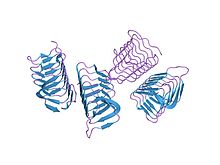The OrJames Lab
.jpg)
.jpg)
.jpg)
.jpg)
.jpg)
.jpg)
.jpg)
The OrJames laboratory investigates a broad range of questions related to physiological mechanisms adapted by freeze-tolerant organisms in winter conditions. I am especially interested in the environmental factors that may lead to the production of antifreeze proteins and varying levels of other natural cryoprotectants, such as glycerol, sorbitol, among others. I than study these cryoprotectants to quantitatively determine their impact on ice recrystallization as experienced by freeze-tolerant organisms and whether activators such as glycerol will affect the potency of the antifreeze proteins' ability to inhibit ice recrystallization. The outcome of this series of experiments will be useful to apply to studies focusing on the preservation of tissues.
Anti-Freeze Proteins

|
One group of cold-hardy agents which do appear to interact directly
with ice, are proteinaceous antifreezes known as antifreeze proteins (AFPs)
(DeVries, 1977). Earlier studies on AFPs describe these proteins as thermal
hysteresis proteins, because they generate a thermal hysteresis effect, which is
the lowering of the freezing point of a substance without affecting the melting
point (DeVries, 1986). Antifreeze proteins can lower the freezing point of
bodily fluids non-colligatively because of specialized chemical properties,
which allow for direct protein-ice interaction. A variety of insects and marine
fish produce AFP polypeptides and glycopeptides that are believed to act by
binding to burgeoning ice crystals in geometrically specific ways, thereby
suppressing growth of ice by preventing water molecules from freely joining
any crystals that begin to form (Raymond et al, 1989). These non-colligative
antifreeze proteins effectively depress the freezing point hundreds of times
more than can be accounted for by simple colligative principles. Thus, these
proteins can be very dilute and yet highly effective. Moreover, non-colligative
antifreezes do not depress the melting point any more than colligative
principles explain. Also, AFPs have been shown to lower the supercooling
point and enhance stability of the supercooled state (Zachariassen 1976). Thus,
having such a substance in the hemolymph, effectively increases supercooling
potential.
In 1964 the first AFP activity was actually discovered by Ramsay,
using the mealworm beetle, Tenebrio molitor (Ramsay 1964). He described
the existence of a substance that lowers the freezing temperature of the
insects’ hemolymph, while not impacting the melting temperature, thus
generating what is now known as thermal hysteresis. His studies established
that the cryptonephridial complex fluid contained a substance that exhibited a
difference in melting and freezing temperatures of up to 8° to 9° C. Although
the agent causing the thermal hysteresis phenomenon was not isolated, nor has
a definitive function of this thermal hysteresis producing substances in the
rectal complex been established, this physical behavior with respect to seed ice
crystals was thought to be related in some way to the powerful water
reabsorbing behavior of the Tenebrio rectal complex. It wasn’t until a
substance producing a similar thermal hysteresis affect was found in Antarctic
fish that the non-colligative antifreeze activity was shown to be significant.
| Ice Recrystallization |
Recrystallization involves the movement of interface boundaries
between ice crystal grains (Knight 1995). Some grains grow larger at the
expense of smaller neighboring ice crystals, which are gradually absorbed by
the growing crystals. The boundary between an actively growing crystal grain
and a neighboring grain is never a straight line but always exhibits curvature.
The boundary tends to migrate toward its center of curvature such that the
degree of curvature is reduced. Therefore grains with concave boundaries
tend to grow while those with convex boundaries tend to decrease in size. The
straightening of curved ice grain boundaries decreases interfacial area, thus
reducing interfacial free energy.
According to this reasoning, boundary curvature between neighboring
crystals should eventually straighten and the associated recrystallization
process should cease. However, the tendency of interfacial tensions to
maintain equilibrium must also be considered (Knight and Duman, 1986).
Neighboring crystal boundaries usually meet in a “Y” shaped configuration
separating the three adjacent crystals. The three angles at the junction tend to
assume a configuration such that the three tensions achieve equilibrium. For
ice crystals, the angles tend to approximate 120° at equilibrium. For most
junctions, the process of boundary straightening or migration tends to disrupt
the 120° equilibrium angles. Since grain boundary shortening or straightening
usually tends to counteract the balance of interfacial tensions at the three-grain
junctions, curvature is continually introduced at the junctions to maintain the
120° angles. The two antagonistic processes—boundary shortening followed
by curvature adjustments at “Y” junctions—cause the continual propagation of
grain boundaries during the course of recrystallization (Burgers 1963).
- Burgers, W.G. (1963) Principles of Recrystallization. In: The Art and Science of Growing Crystals. J.J. Gilman, ed. John Wiley & Sons, Inc., New York, pp. 416-460.
- DeVries, A.L. and Lin, Y. (1977) Structure of peptide antifreeze and mechanism of adsorption to ice. Biochem. Biophys. Acta. 495: 388-392.
- DeVries, A.L. (1986) Antifreeze glycoproteins and peptides: Interactions with ice and water. Meth. Enzymol. 127: 293-303.
- Knight, C.A. and Duman, J.G. (1986) inhibition of recrystallization of ice by insect thermal hysteresis proteins: A possible cryoprotective role. Cryobiology. 23: 256-262.
- Knight, C. A., Wen, D. Laursen, A. R. (1995) Nonequilibrium Antifreeze Peptides and the Recrystallization of Ice. Cryobiology 32: 23-34.
- Ramsay, R.A. (1964) The rectal complex of the mealworm, Tenebrio molitor. Phil. Trans. R. Soc. London B 248: 279-314.
- Raymond, J.A., Wilson, P.W. and DeVries, A.L. (1989) Inhibition of growth on nonbasal planes in ice by fish antifreeze. Proc. Natn. Acad. Sci. U.S.A. 86: 881-885.
- Zachariassen, K.E., and Hammel, H. T. (1976) Nucleating agents in the haemolymph of insects tolerant to freezing. Nature (London) 262: 285-287.